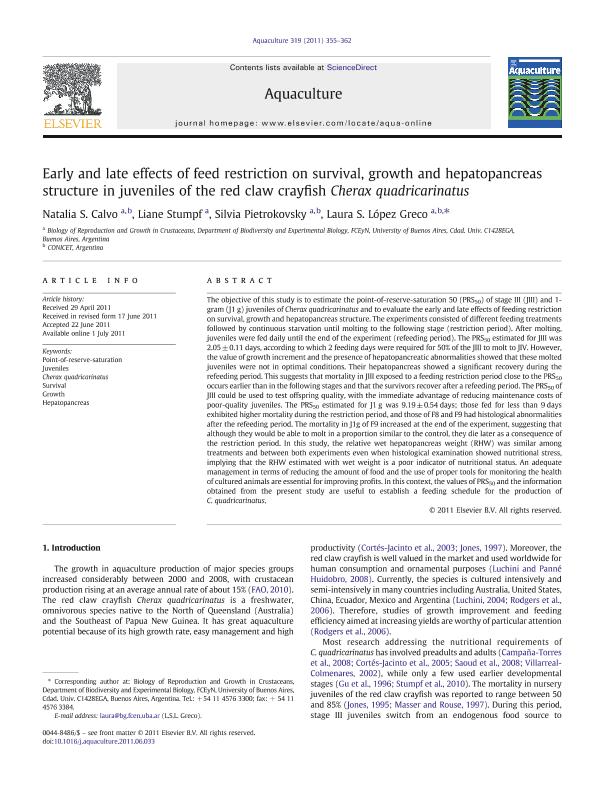Mostrar el registro sencillo del ítem
dc.contributor.author
Calvo, Natalia Soledad

dc.contributor.author
Stumpf, Liane

dc.contributor.author
Pietrokovsky, Silvia Monica

dc.contributor.author
Lopez, Laura Susana

dc.date.available
2020-03-11T18:09:38Z
dc.date.issued
2011-10
dc.identifier.citation
Calvo, Natalia Soledad; Stumpf, Liane; Pietrokovsky, Silvia Monica; Lopez, Laura Susana; Early and late effects of feed restriction on survival, growth and hepatopancreas structure in juveniles of the red claw crayfish Cherax quadricarinatus; Elsevier Science; Aquaculture; 319; 3-4; 10-2011; 355-362
dc.identifier.issn
0044-8486
dc.identifier.uri
http://hdl.handle.net/11336/99158
dc.description.abstract
The objective of this study is to estimate the point-of-reserve-saturation 50 (PRS50) of stage III (JIII) and 1-gram (J1g) juveniles of Cherax quadricarinatus and to evaluate the early and late effects of feeding restriction on survival, growth and hepatopancreas structure. The experiments consisted of different feeding treatments followed by continuous starvation until molting to the following stage (restriction period). After molting, juveniles were fed daily until the end of the experiment (refeeding period). The PRS50 estimated for JIII was 2.05±0.11days, according to which 2 feeding days were required for 50% of the JIII to molt to JIV. However, the value of growth increment and the presence of hepatopancreatic abnormalities showed that these molted juveniles were not in optimal conditions. Their hepatopancreas showed a significant recovery during the refeeding period. This suggests that mortality in JIII exposed to a feeding restriction period close to the PRS50 occurs earlier than in the following stages and that the survivors recover after a refeeding period. The PRS50 of JIII could be used to test offspring quality, with the immediate advantage of reducing maintenance costs of poor-quality juveniles. The PRS50 estimated for J1g was 9.19±0.54days; those fed for less than 9days exhibited higher mortality during the restriction period, and those of F8 and F9 had histological abnormalities after the refeeding period. The mortality in J1g of F9 increased at the end of the experiment, suggesting that although they would be able to molt in a proportion similar to the control, they die later as a consequence of the restriction period. In this study, the relative wet hepatopancreas weight (RHW) was similar among treatments and between both experiments even when histological examination showed nutritional stress, implying that the RHW estimated with wet weight is a poor indicator of nutritional status. An adequate management in terms of reducing the amount of food and the use of proper tools for monitoring the health of cultured animals are essential for improving profits. In this context, the values of PRS50 and the information obtained from the present study are useful to establish a feeding schedule for the production of C. quadricarinatus.
dc.format
application/pdf
dc.language.iso
eng
dc.publisher
Elsevier Science

dc.rights
info:eu-repo/semantics/openAccess
dc.rights.uri
https://creativecommons.org/licenses/by-nc-sa/2.5/ar/
dc.subject
CHERAX QUADRICARINATUS
dc.subject
GROWTH
dc.subject
HEPATOPANCREAS
dc.subject
JUVENILES
dc.subject
POINT-OF-RESERVE-SATURATION
dc.subject
SURVIVAL
dc.subject.classification
Otras Producción Animal y Lechería

dc.subject.classification
Producción Animal y Lechería

dc.subject.classification
CIENCIAS AGRÍCOLAS

dc.title
Early and late effects of feed restriction on survival, growth and hepatopancreas structure in juveniles of the red claw crayfish Cherax quadricarinatus
dc.type
info:eu-repo/semantics/article
dc.type
info:ar-repo/semantics/artículo
dc.type
info:eu-repo/semantics/publishedVersion
dc.date.updated
2020-02-27T18:50:21Z
dc.journal.volume
319
dc.journal.number
3-4
dc.journal.pagination
355-362
dc.journal.pais
Países Bajos

dc.journal.ciudad
Amsterdam
dc.description.fil
Fil: Calvo, Natalia Soledad. Universidad de Buenos Aires. Facultad de Ciencias Exactas y Naturales. Departamento de Biodiversidad y Biología Experimental; Argentina. Consejo Nacional de Investigaciones Científicas y Técnicas; Argentina
dc.description.fil
Fil: Stumpf, Liane. Universidad de Buenos Aires. Facultad de Ciencias Exactas y Naturales. Departamento de Biodiversidad y Biología Experimental; Argentina. Consejo Nacional de Investigaciones Científicas y Técnicas; Argentina
dc.description.fil
Fil: Pietrokovsky, Silvia Monica. Universidad de Buenos Aires. Facultad de Ciencias Exactas y Naturales. Departamento de Biodiversidad y Biología Experimental; Argentina. Consejo Nacional de Investigaciones Científicas y Técnicas; Argentina
dc.description.fil
Fil: Lopez, Laura Susana. Universidad de Buenos Aires. Facultad de Ciencias Exactas y Naturales. Departamento de Biodiversidad y Biología Experimental; Argentina. Consejo Nacional de Investigaciones Científicas y Técnicas; Argentina
dc.journal.title
Aquaculture

dc.relation.alternativeid
info:eu-repo/semantics/altIdentifier/url/https://www.sciencedirect.com/science/article/pii/S0044848611005138
dc.relation.alternativeid
info:eu-repo/semantics/altIdentifier/doi/http://dx.doi.org/10.1016/j.aquaculture.2011.06.033
Archivos asociados
